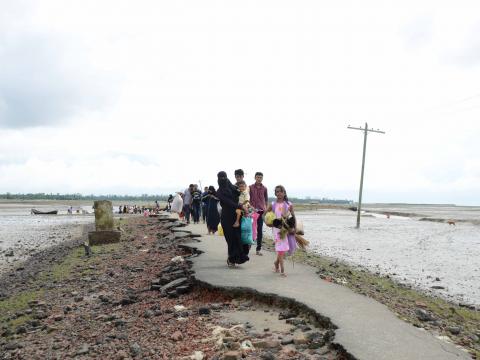Photo Gallery | Two Years On Rohingya Refugee Response | 25 August 2019









World Vision supports more than 370,000 Rohingya refugees living in the 23 camps, and Bangladeshis in need in host communities.We provide principled, timely protection and assistance, which promotes the dignity of people, especially the children. Photo: Jon Warren

Rohingya children face many risks in the hazardous camps, including injury, exploitation, abuse, child labour and abduction. Being in school helps keep them safe. Photo: Jon Warren


In the Rohingya culture, adolescent girls are usually restricted to their homes when they reach puberty. However, many parents are eager to have their girls learn new skills at our training centres, such as tailoring, handicraft production and basic literacy. Photo: Md. Shabir Hussain


Our women’s safe space is a place where women can build support networks as they learn new skills together for a better future. Photo: Karen Homer



Rohingya children learn about the importance of handwashing through our hygiene promotion sessions. World Vision has provided more than 300,000 refugees with water and sanitation services. Photo: Jon Warren

World Vision works to prevent and treat malnutrition among children under age 5 in its three feeding centres, operated in partnership with the World Food Programme. Photo: Jon Warren


World Vision is providing direct life-saving food assistance to an estimated 247,415 people, working in partnership with World Food Programme. Refugees receive pre-paid e-vouchers that they use to purchase food from WFP shops. They no longer have to queue up for hours to get their monthly rations. Photo: Md. Shabir Hussain

Many Rohingya children must collect firewood daily so their families can cook. Their parents worry about them going to the distant forest, but it was the only option. Photo: Jon Warren

World Vision’s 42 Community Cooking and Learning Centres are equipped with five two-burner stoves fuelled by propane gas. Up to 1,050 women cook meals daily in the centres, benefiting some 5,250 family members. Their children no longer have to collect firewood. At the centres, mothers learn new skills, such as nutritious cooking and vegetable gardening. Photo: Jon Warren

World Vision hired 14,922 refugees, including 1,906women, to construct roads, pathways and bridges to prepare for the monsoon season. The result: no lives were lost during the storms and flooding. Photo: Jon Warren

To support local communities in need and provide short-term jobs, World Vision hired residents to strengthen infrastructure to prepare for the monsoons. This renovated school now doubles as a cyclone shelter for up to 6,000 people. Photo: Himaloy Joseph Mree

World Vision continues to advocate for the Rohingya’s safe, voluntary and dignified return to Myanmar, when conditions are conducive to do so. Until then, we will promote refugees’ dignity and self-reliance, and support host community families. Photo: Jon Warren
Share